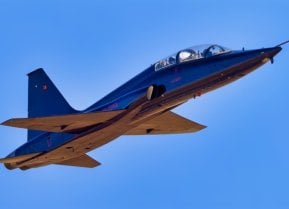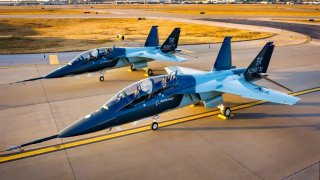Meet the T-7 Red Hawk: The Air Force's Long-Awaited T-38 Talon Replacement
The first production T-7 Red Hawk was rolled off the assembly line on April 28, 2022, and will soon begin replacing the T-38 at training squadrons around the country.
After more than six decades of training U.S. Air Force (USAF) pilot candidates, the T-38 Talon is set to be phased out. The T-38’s replacement is the winner of the T-X program contract—the Boeing-Saab T-7 Red Hawk.
Winning the T-X contract
The T-X program was the USAF’s development and acquisition program for a new two-seat jet trainer to replace the Northrop T-38 Talon. Three proposals were submitted for the T-X contract: The Lockheed Martin/KAI T-50A; the Leonardo T-100; and the Boeing-Saab T-X.
The origins of the T-X program can be traced back to 2003, when the USAF’s Air Education and Training Command (AETC) began developing the requirements for a T-38 replacement. The impetus for AETC’s work was the age of the T-38 fleet, most of which was over 50 years old and beginning to suffer from fatigue failures, as demonstrated in a 2008 crash that killed two pilots.
The T-X program was delayed and at times, seemed in peril, thanks to the fiscal climate of the early 2010s. The program was even omitted entirely from the fiscal year 2014 budget, casting serious doubts on the future of the T-38 replacement. However, in early 2015, the USAF released the T-X program requirements. The requirements demanded that the new trainer be equipped to prepare pilots for the increasingly complex cockpit environment—especially with respect to information management, as seen in fifth-generation fighters like the F-22 and F-35. Additionally, the T-X would need to fulfill several basic training roles, including basic aircraft control; airmanship; formation; instrument and navigation; advanced air-to-air; advanced air-to-ground; and advanced crew/cockpit resource management. Plus, the T-X jet was expected to fulfill five advanced training roles, which included: sustained high-G operations at 6.5-7.5g; aerial refueling; night vision imaging systems operations; air-to-air intercepts; and data-link operations.
In late 2016, the USAF released a formal request for proposals—which called for 350 aircraft and initial operational capability by 2024. The three submissions were considered and on September 27, 2018, the USAF announced the Boeing entry had been selected. The USAF would purchase 351 aircraft and forty-six simulators for about $11 billion.
Introducing the T-7 Red Hawk
Boeing-Saab submitted their proposal under the designation “T-X.” But once the trainer was selected as the winner, the jet was redesignated as the T-7 Red Hawk, in honor of the Tuskegee Redtails. The winning bid featured a single-engine with a twin-tail, tandem seating, and retractable tricycle landing gear. The jet relied upon a General Electric F404 afterburning turbofan engine, capable of providing up to 19,000 pounds of thrust.
The first production T-7 was rolled off the assembly line on April 28, 2022, and will soon begin replacing the T-38 at training squadrons around the country. Boeing-Saab also intends to develop an armed version of the T-7, which can be solicited to air forces around the world as a replacement for the Northrop F-5 and Dassault/Dorner Alpha Jet. Boeing hopes to sell up to 2,700 T-7s worldwide. An armed version of the T-7 would likely be used as an aggressor, or light attack/fighter role.
Harrison Kass is a defense and national security writer with over 1,000 total pieces on issues involving global affairs. An attorney, pilot, guitarist, and minor pro hockey player, Harrison joined the US Air Force as a Pilot Trainee but was medically discharged. Harrison holds a BA from Lake Forest College, a JD from the University of Oregon, and an MA from New York University. Harrison listens to Dokken.
Image Credit: Creative Commons.


